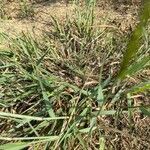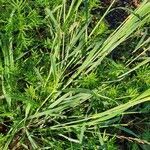Densely tufted perennial to 800 mm high; basal sheaths glabrous or thinly silky-hairy; leaves mainly basal; culms unbranched, eglandular. Leaf blade 60-100 x 2-5 mm; eglandular. Inflorescence open or contracted, sparsely branched, secondary branches present or absent; primary branches stiff, with 2-4 spikelets, lowest branches not whorled to sub-whorled; pedicels short, stout. Spikelet 3-10 x 1.5-4.5 mm, dark greenish-grey, olive or brownish-grey, outline usually smooth; rachilla persistent; lemmas and/or paleas breaking up from base upwards; glumes subequal, reaching 1/3-1/2 up lemma above, ovate in side-view, boat-shaped, apex obtuse, cartilaginous; lemma 1.7-3.8 mm long, apex obtuse to subacute, keeled, lateral nerves indistinct to ± distinct; palea persistent, keels a narrow thickened ridge, entire, wingless, scaberulous, margins wide apart, ± same width between keels and margins; anthers 3, 0.7-1.6 mm long; caryopsis almost square.
Spikelets 3–10(15) × 1.5–4.5 mm, typically narrowly ovate, but varying from narrowly oblong to subrotund, laterally compressed, 6–16(40)-flowered, the lemmas disarticulating from below upwards, the rhachilla persistent; glumes subequal, 1.2–2.8 mm long, reaching to between 1/3 and 1/2 the way along the adjacent lemmas, keeled, narrowly ovate in profile, scabrid on the keel, obtuse at the apex; lemmas 1.7–3.8 mm long, keeled, ovate to broadly ovate in profile, cartilaginous with indistinct lateral nerves, at length widely diverging from the rhachilla, those in opposite rows not imbricate, the rhachilla visible between them, olive-to dark green, glabrous, subacute at the apex; palea persistent, glabrous on the flanks, the keels slender, wingless, scaberulous; anthers 3, 0.7–1.3 mm long.
Densely tufted perennial, up to 800 mm high; leaves mainly basal; basal sheaths glabrous or thinly silky hairy. Leaf blade 60-100 x 2-5 mm; ligule a fringe of hairs. Inflorescence an open or contracted panicle, sparsely branched, secondary branches present or absent, primary branches stiff; 2-4 spikelets on short stout pedicels. Spikelets 3-10 x 1.5-4.5 mm, dark greenish grey, olive or brownish grey, outline usually smooth, laterally compressed; rachilla persistent, lemmas and/or paleas breaking up from base upwards; glumes shorter than spikelet, cartilaginous, ovate, boat-shaped, 1-nerved. Florets many; lemma entire, 3-nerved, lateral nerves indistinct; palea keels a narrow ridge, entire, scaberulous; anthers 3, 1.0-1.6 mm long. Flowering time Aug.-May. Caryopsis almost square.
Perennial; up to 0.8 m high; densely tufted; leaves mainly basal. Leaf blades 60-100 x 2-5 mm; basal sheaths glabrous or thinly silky hairy. Flowers: panicle open or contracted; sparsely branched; secondary branches present or absent; primary branches stiff; with 2-4 spikelets on short; stout pedicels; spikelets 3-10 x 1.5-4.5 mm; dark greenish grey; olive or brownish grey; outline usually smooth; rachilla persistent; lemmas and/or paleae breaking up from base upwards; glumes cartilaginous; ovate; boat-shaped; lower glume narrowly ovate in side view; apex obtuse; lemma with lateral nerves indistinct; palea keels a narrow ridge; entire; scaberulous; anthers 3; 1.0-1.6 mm long; caryopsis almost square.
Perennial, densely tufted (leaves mainly basal), up to 0.8 m high. Leaf blades 60-100 mm long, 2-5 mm wide. Basal sheaths glabrous or thinly silky-hairy. Spikelets 3-10 mm long, 1.5-4.5 mm wide. Inflorescence open or contracted, sparsely branched, secondary branches present or absent, primary branches stiff, with 2-4 spikelets on short stout pedicels; spikelets dark greenish grey, olive or brownish grey, outline usually smooth, rhachilla persistent, lemmas and/or paleas breaking up from base upwards; glumes cartilaginous, ovate, boat-shaped; lemma with lateral nerves indistinct; palea keels a narrow ridge, entire, scaberulous; anthers 3, 1.0-1.6 mm long. Caryopsis almost square.
Caespitose perennial without rhizomes or stolons; culms up to 90 cm tall, erect, unbranched, glabrous at the nodes, eglandular; basal leaf sheaths glabrous or thinly silky-pilose, chartaceous, terete, eglandular, persistent or sometimes decaying into fibres; ligule a line of hairs; leaf laminas 6–10(30) cm × 2–5 mm, linear, flat or involute, glabrous to pilose on both sides, eglandular.
Panicle 3–18 cm long, narrowly ovate or rarely narrowly oblong, open or ± contracted, the primary branches stiff, racemose or with short branchlets bearing only 1 or 2 spikelets, these spreading on pedicels 1–2 mm long, the primary branches not in whorls, terminating in a fertile spikelet, glabrous or pubescent in the axils, eglandular.
Perennial to 80 mm. Leaves linear, glabrous or thinly silky hairy. Spikelets in a lax panicle, 3-10 x 2-5 mm, olive, lowest lemma with lateral nerves indistinct.
Caryopsis 0.5–0.7 mm long, almost square.





